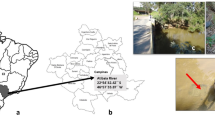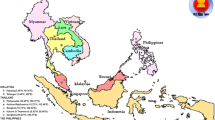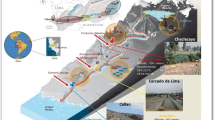Abstract
Starting in 2006, a monitoring of Giardia lamblia and Cryptosporidium parvum occurrence was conducted for 2 years in the largest drinking water reservoir of Luxembourg (Esch-sur-Sûre reservoir) using microscopy and qPCR techniques. Parasite analyses were performed on water samples collected from three sites: site A located at the inlet of the reservoir, site B located 18 km downstream site A, at the inlet of the drinking water treatment plant near the dam of the reservoir and site C where the finished drinking water is injected in the distribution network. Results show that both parasites are present in the reservoir throughout the year with a higher occurrence of G. lamblia cysts compared to C. parvum oocysts. According to our results, only 25% of the samples positive by microscopy were confirmed by qPCR. (Oo)cyst concentrations were 10 to 100 times higher at site A compared to site B and they were positively correlated to the water turbidity and negatively correlated to the temperature. Highest (oo)cyst concentrations were observed in winter. In contrast, no relationship between the concentrations of (oo)cysts in the reservoir and rain events could be established. Though a correlation has been observed between both parasites and faecal indicators in the reservoir, some discrepancies highlight that the latter do not represent a reliable tool to predict the presence/absence of these pathogenic protozoa. In summer 2007, the maximal risk of parasite infection per exposure event for swimmers in the reservoir was estimated to be 0.0015% for C. parvum and 0.56% for G. lamblia. Finally, no (oo)cysts could be detected in large volumes of finished drinking water.
Similar content being viewed by others
References
Bertrand, I., & Schwartzbrod, J. (2007). Detection and genotyping of Giardia duodenalis in wastewater: Relation between assemblages and faecal contamination origin. Water Research, 41(16), 3675–3682.
Betancourt, W. Q., & Rose, J. B. (2004). Drinking water treatment processes for removal of Cryptosporidium and Giardia. Veterinary Parasitology, 126(1–2), 219–234.
Briancesco, R., & Bonadonna, L. (2005). An Italian study on Cryptosporidium and Giardia in wastewater, fresh water and treated water. Environmental Monitoring and Assessment, 104(1–3), 445–457.
Brookes, J. D., Antenucci, J., Hipsey, M., Burch, M. D., Ashbolt, N. J., & Ferguson, C. (2004). Fate and transport of pathogens in lakes and reservoirs. Environment International, 30(5), 741–759.
Brookes, J. D., Hipsey, M. R., Burch, M. D., Regel, R. H., Linden, L. G., Ferguson, C. M., et al. (2005). Relative value of surrogate indicators for detecting pathogens in lakes and reservoirs. Environmental Sience and Technology, 39(22), 8614–8621.
Castro-Hermida, J. A., Garcia-Presedo, I., Gonzalez-Warleta, M., & Mezo, M. (2010). Cryptosporidium and Giardia detection in water bodies of Galicia, Spain. Water Research (in press).
Davies, C. M., Long, J. A., Donald, M., & Ashbolt, N. J. (1995). Survival of fecal microorganisms in marine and freshwater sediments. Applied Environmental Microbiology, 61(5), 1888–1896.
Davies, C. M., Kaucner, C., Deere, D., & Ashbolt, N. J. (2003). Recovery and enumeration of Cryptosporidium parvum from animal fecal matrices. Applied Environmental Microbiology, 69(5), 2842–2847.
Dawson, D. (2005). Foodborne protozoan parasites. International Journal of Food Microbiology, 103(2), 207–227.
Dufour, A. P., Evans, O., Behymer, T. D., & Cantu, R. (2006). Water ingestion during swimming activities in a pool: A pilot study. Journal of Water Health, 4(4), 425–430.
Fayer, R. (2004). Cryptosporidium: A water-borne zoonotic parasite. Veterinary Parasitology, 126(1–2), 37–56.
Fayer, R., Morgan, U., & Upton, S. J. (2000). Epidemiology of Cryptosporidium: Transmission, detection and identification. International Journal for Parasitology, 30(12–13), 1305–1322.
Fontaine, M., & Guillot, E. (2003). An immunomagnetic separation-real-time PCR method for quantification of Cryptosporidium parvum in water samples. Journal of Microbiological Methods, 54(1), 29–36.
Giangaspero, A., Cirillo, R., Lacasella, V., Lonigro, A., Marangi, M., Cavallo, P., et al. (2009). Giardia and Cryptosporidium in inflowing water and harvested shellfish in a lagoon in Southern Italy. Parasitology International, 58(1), 12–17.
Guy, R. A., Payment, P., Krull, U. J., & Horgen, P. A. (2003). Real-time PCR for quantification of Giardia and Cryptosporidium in environmental water samples and sewage. Applied Environmental Microbiology, 69(9), 5178–5185.
Hallier-Soulier, S., & Guillot, E. (2000). Detection of cryptosporidia and Cryptosporidium parvum oocysts in environmental water samples by immunomagnetic separation-polymerase chain reaction. Journal of Applied Microbiology, 89(1), 5–10.
Hanninen, M. L., Horman, A., Rimhanen-Finne, R., Vahtera, H., Malmberg, S., Herve, S., et al. (2005). Monitoring of Cryptosporidium and Giardia in the Vantaa river basin, southern Finland. International of Hygiene and Environmental Health, 208(3), 163–171.
Helmi, K., Skraber, S., Gantzer, C., Willame, R., Hoffmann, L., & Cauchie, H. M. (2008). Interactions of Cryptosporidium parvum, Giardia lamblia, vaccinal poliovirus type 1, and bacteriophages phiX174 and MS2 with a drinking water biofilm and a wastewater biofilm. Applied Environmental Microbiology, 74(7), 2079–2088.
Horman, A., Rimhanen-Finne, R., Maunula, L., von Bonsdorff, C. H., Torvela, N., Heikinheimo, A., et al. (2004). Campylobacter spp., Giardia spp., Cryptosporidium spp., noroviruses, and indicator organisms in surface water in southwestern Finland, 2000-2001. Applied Environmental Microbiology, 70(1), 87–95.
Jellison, K. L., Hemond, H. F., & Schauer, D. B. (2002). Sources and species of cryptosporidium oocysts in the Wachusett Reservoir watershed. Applied Environmental Microbiology, 68(2), 569–575.
Jiang, J., Alderisio, K. A., Singh, A., & Xiao, L. (2005). Development of procedures for direct extraction of Cryptosporidium DNA from water concentrates and for relief of PCR inhibitors. Applied Environmental Microbiology, 71(3), 1135–1141.
Johnson, D. W., Pieniazek, N. J., Griffin, D. W., Misener, L., & Rose, J. B. (1995). Development of a PCR protocol for sensitive detection of Cryptosporidium oocysts in water samples. Applied Environmental Microbiology, 61(11), 3849–3855.
LeChevallier, M. W., Norton, W. D., & Lee, R. G. (1991). Giardia and Cryptosporidium spp. in filtered drinking water supplies. Applied Environmental Microbiology, 57(9), 2617–2621.
Miller, W. A., Lewis, D. J., Pereira, M. D., Lennox, M., Conrad, P. A., Tate, K. W., et al. (2008). Farm factors associated with reducing Cryptosporidium loading in storm runoff from dairies. Journal of Environmental Quality, 37(5), 1875–1882.
Mons, C., Dumetre, A., Gosselin, S., Galliot, C., & Moulin, L. (2009). Monitoring of Cryptosporidium and Giardia river contamination in Paris area. Water Research, 43(1), 211–217.
Mueller-Doblies, D., Giles, M., Elwin, K., Smith, R. P., Clifton-Hadley, F. A., & Chalmers, R. M. (2008). Distribution of Cryptosporidium species in sheep in the UK. Veterinary Parasitology, 154(3–4), 214–219.
Obiri-Danso, K., & Jones, K. (1999). Distribution and seasonality of microbial indicators and thermophilic campylobacters in two freshwater bathing sites on the River Lune in northwest England. Journal of Applied Microbiology, 87(6), 822–832.
Olson, M. E., Goh, J., Phillips, M., Guselle, N., & McAllister, T. A. (1999). Giardia Cyst and Cryptosporidium Oocyst Survival in Water, Soil, and Cattle Feces. Journal of Environmental Quality, 28(6), 1991–1996.
Payment, P., & Franco, E. (1993). Clostridium perfringens and somatic coliphages as indicators of the efficiency of drinking water treatment for viruses and protozoan cysts. Applied Environmental Microbiology, 59(8), 2418–2424.
Pereira, S. J., Ramirez, N. E., Xiao, L., & Ward, L. A. (2002). Pathogenesis of human and bovine Cryptosporidium parvum in gnotobiotic pigs. Journal of Infectious Disease, 186(5), 715–718.
Quilez, J., Torres, E., Chalmers, R. M., Hadfield, S. J., Del, C. E., & Sanchez-Acedo, C. (2008). Cryptosporidium genotypes and subtypes in lambs and goat kids in Spain. Applied Environmental Microbiology, 74(19), 6026–6031.
Ramirez, N. E., & Sreevatsan, S. (2006). Development of a sensitive detection system for Cryptosporidium in environmental samples. Veterinary Parasitology, 136(3–4), 201–213.
Rendtorff, R. C., & Holt, C. J. (1954). The experimental transmission of human intestinal protozoan parasites. IV. Attempts to transmit Endamoeba coli and Giardia lamblia cysts by water. American Journal of Hygien, 60(3), 327–338.
Robertson, L. J., & Gjerde, B. (2001). Occurrence of Cryptosporidium oocysts and Giardia cysts in raw waters in Norway. Scandinavian Journal of Public Health, 29(3), 200–207.
Robertson, L. J., Campbell, A. T., & Smith, H. V. (1992). Survival of Cryptosporidium parvum oocysts under various environmental pressures. Applied Environmental Microbiology, 58(11), 3494–3500.
Robertson, L. J., Forberg, T., Hermansen, L., Gjerde, B. K., Alvsvag, J. O., & Langeland, N. (2006). Cryptosporidium parvum infections in Bergen, Norway, during an extensive outbreak of waterborne giardiasis in autumn and winter 2004. Applied Environmental Microbiology, 72(3), 2218–2220.
Santin, M., Trout, J. M., Xiao, L., Zhou, L., Greiner, E., & Fayer, R. (2004). Prevalence and age-related variation of Cryptosporidium species and genotypes in dairy calves. Veterinary Parasitology, 122(2), 103–117.
Santin, M., Trout, J. M., & Fayer, R. (2008). A longitudinal study of cryptosporidiosis in dairy cattle from birth to 2 years of age. Veterinary Parasitology, 155(1–2), 15–23.
Schets, F. M., van Wijnen, J. H., Schijven, J. F., Schoon, H., & Roda Husman, A. M. (2008). Monitoring of waterborne pathogens in surface waters in Amsterdam, The Netherlands, and the potential health risk associated with exposure to Cryptosporidium and Giardia in these waters. Applied Environmental Microbiology, 74(7), 2069–2078.
Smith, H. V., Caccio, S. M., Tait, A., McLauchlin, J., & Thompson, R. C. (2006). Tools for investigating the environmental transmission of Cryptosporidium and Giardia infections in humans. Trends in Parasitology, 22(4), 160–167.
Tallon, P., Magajna, B., Lofranco, C., & Leung, K. T. (2006). Microbial Indicators Of Faecal Contamination In Water: A Current Perspective. Water, Air and Soil Pollution, 166, 139–166.
Teunis, P. F. M., van der Heijen, O. G., van der Giessen, J. W. B., & Havelaar, A. H. (1996). Dose response relation in human volunteers for gastro-intestinal pathogens. RIVM report nr.284550002, 1–97.
Touron, A., Berthe, T., Gargala, G., Fournier, M., Ratajczak, M., Servais, P., et al. (2007). Assessment of faecal contamination and the relationship between pathogens and faecal bacterial indicators in an estuarine environment (Seine, France). Marine Pollution Bulletin, 54(9), 1441–1450.
Tzipori, S., & Widmer, G. (2008). A hundred-year retrospective on cryptosporidiosis. Trends in Parasitology, 24(4), 184–189.
USEPA 1623 (2001). Cryptosporidium and Giardia in Water Filtration/IMS/FA. Protocol, EPA 821-R-01-025. Office of Water, U.S. Environmental Protection Agency, Washington, D.C.
Verweij, J. J., Blange, R. A., Templeton, K., Schinkel, J., Brienen, E. A., van Rooyen, M. A., et al. (2004). Simultaneous detection of Entamoeba histolytica, Giardia lamblia, and Cryptosporidium parvum in fecal samples by using multiplex real-time PCR. Journal of Clinical Microbiology, 42(3), 1220–1223.
Willame, R., Thys, I., Jacquet, V., Berbanck, M., Cauchie, H. M., & Hoffmann, L. (2008). Environmental variables involved in the development of bloom-forming cyanobacteria in a meso-eutrophic reservoir. Algological Studies, 126, 227–247.
Xiao, L., & Fayer, R. (2008). Molecular characterisation of species and genotypes of Cryptosporidium and Giardia and assessment of zoonotic transmission. International Journal for Parasitology, 38(11), 1239–1255.
Author information
Authors and Affiliations
Corresponding author
Rights and permissions
About this article
Cite this article
Helmi, K., Skraber, S., Burnet, JB. et al. Two-year monitoring of Cryptosporidium parvum and Giardia lamblia occurrence in a recreational and drinking water reservoir using standard microscopic and molecular biology techniques. Environ Monit Assess 179, 163–175 (2011). https://doi.org/10.1007/s10661-010-1726-7
Received:
Accepted:
Published:
Issue Date:
DOI: https://doi.org/10.1007/s10661-010-1726-7




